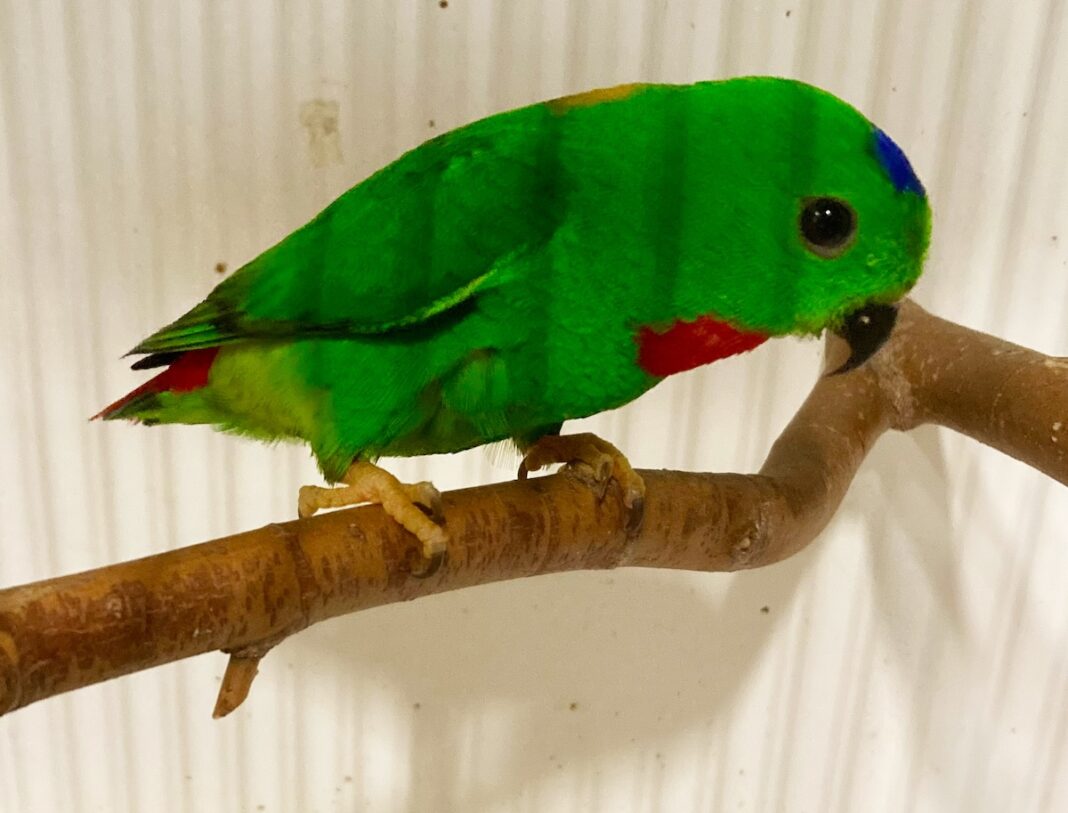Professional keeper CHRIS GREEN gives us a heads up on this irresistible species, which sleeps with its head down! And that’s only the start of its charm
THE vibrantly coloured blue-crowned hanging parrot (Loriculus galgulus) is one of 15 species in this genus of birds which are noted for their ability to sleep upside-down. It is thought this is to deter nocturnal predators. In parts of their range, they are known as bat parrot because of this behaviour. The habit is so automatic that they will even hang upside down when resting during the day. A good sign that one of these birds may be unwell is a reluctance to hang upside down.
Hanging parrots are rare in aviculture and the blue-crowned is arguably the most established. Currently, three UK zoos have a colony of blue-crowned: Chester, Newquay and the Cotswold Wildlife Park. Our colony came from Newquay Zoo three years ago and consisted of three sexed pairs.
In the wild they are found in Thailand, Malaysia, Singapore, Indonesia and Brunei, where they inhabit forests and mangrove swamps, as well as gardens and plantations.
Blue-crowned hanging parrots have green plumage and a black beak. Males have a red mark on their throat, a red rump and a yellow lower back, along with a characteristic blue crown patch on their head. In females, the blue crown is either much fainter or non-existent, and they don’t have red patches. These are not loud birds. Their natural calls are melodic and often pleasing to hear. They consist of soft tweets and chirps.
We have enjoyed breeding success each year since their arrival, but the numbers produced have varied. We had two in the first year, four the following season and only a singleton this season. In 2024 we had lots of clear eggs and perhaps some members of the group are a bit young.
Courtship and nesting
When displaying to potential partners, males will fluff up their red throat feathers, strut, and show off their red and gold rump in an effort to impress. Wild birds nest in tree cavities, but a nest-box will be used in captivity. One suitable for lovebirds is a minimum, though some birds will prefer a larger one that allows them to “furnish” it as they prefer. They will add willow bark and leaves to the nest-box, along with feathers.
Three or four eggs are laid and incubated by the hen for some 21 days and then the chicks fledge at 35 days. They are not considered to be a particularly easy species to breed so patience is needed. At Cotswold Wildlife Park, all the nest-boxes are placed in the indoor quarters, to exclude any threats from poor weather and other disturbances.
Whereas Newquay’s hanging parrots are accommodated in a tropical house, the Cotswold aviary is a heated indoor section, which leads to a large outdoor flight with pond and bamboo planting. The parrots are not overly destructive to the internal planting. Our indoor aviary is actually two flights, which means that the birds can be closed in to one of them. That makes catching up an easier task if you need to do it. Hanging parrots are delicate and ours only have access to the outside enclosure from April until the end of September. As a result of the liquid nature of their droppings the walls and enclosure are cleaned down daily, to avoid any chance of a build-up of bacteria. Bathing is also most important and our birds have access to the pond and several baths in the indoor section.
Their diet is a wide mixture of fruit, T16 pellets and nectar. Fruit is provided on metal skewers, which are hung in both the indoor and outdoor quarters. The hanging parrots thoroughly enjoy these sweet kebabs. Nectar is replaced twice a day to maintain its freshness and avoid intestinal issues. Fruit is alternated to maintain variety and interest. Melon, apple, orange, papaya, banana, mango and pear are some that are fed.
Alongside frequent cleaning of the enclosure, we make regular checks of the birds’ feet, because their claws seem to grow at an exceptional rate!
Find more news and articles like this on the Cage & Aviary Birds website. Subscribe to Cage & Aviary Birds magazine now.


